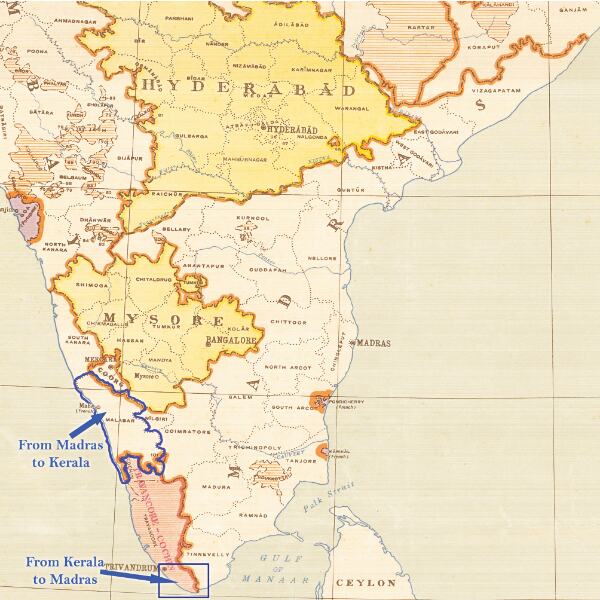Formation of Kerala — II
Charting the tumultuous political process that transformed the erstwhile state of Travancore-Cochin to the present-day state of Kerala

The three-dimensional patchwork of Travancore-Cochin (TC): jurisdictions, social groups and political organisations coupled with an intense struggle between the Congress and the Communists, with the socialists playing one against the other to suit their convenience meant that political stability was a far cry in the short-lived state. As influential, if not more than the political parties were the Shree Narayana Dharma Prachalan (SNDP), the Nair Service
Society (NSS) as well as the Church-affiliated educational and social institutions. The Library and Reading room
movement also played its distinct role for these were 'spaces' where people could read and discuss the newspapers, periodicals and publications with a general affiliation to the ideological dispensation.
In what must be a record in itself, the state had five Chief Ministers and a term of President's rule in its seven years of existence. The first Chief Minister Paravoor TK Narayan Pillai was the Secretary of the Travancore Cochin Congress in 1932, and it's President in 1938. He took office on July 1, 1949. Part of his organisational strength and reach came from the 'Aikya Thiruvitahmcore–Cochin Grandhasala Sanghom', a voluntary group that promoted public libraries and reading rooms. The state was still reeling under the impact of the Punnapra–Valyar revolutionary upsurge led by the Communist Party of India (CPI). Apart from banning the party, Pillai also took large scale measures to suppress the movement that was organising demonstrations against the landlords and factory owners. An internecine rift within his own Cabinet saw him tender his resignation within eighteen months.
He was succeeded by C Kesavan in February 1951 who had strong affiliations with SNDP, an organisation founded by Sri Narayana Guru for the social, economic and educational advancement of Ezhavas, and to impart amongst them a consciousness of their own dignity and strength as an integral part of the wider Hindu consciousness. Although Kesavan was an atheist, his involvement in SNDP arrested the tide of conversions of Ezhavas to Christianity and Islam. He worked for temperance and eradication of untouchability, for he had suffered discrimination as an Ezhava boy on the streets and other public places. Incidentally, the ex-CM TK Narayana Pillai joined his cabinet. For the record, the historic Land Reforms Bill was piloted by him, but he was not backed by the vested interests within his own party. Of course, in hindsight, it can be said that if this Bill had been enacted and implemented, the ideological discourse and differences with the Communists and the Socialists would have been muted. After the declaration of General Elections of 1952, he relinquished power.
In the first general elections (1952) the Congress was the single largest party but was eleven seats short of a majority. It therefore aligned with the Travancore Tamil Nadu Congress (TTNC), Kerala Socialist Party to cobble up a coalition under the leadership of AA John. It was an inherently flawed arrangement as the main plank of the TTNC was the demand for transfer of Kanyakumari district from TC to Madras (as Tamil Nadu was then called). As the ban on the CPI had not been lifted till the announcement of elections, their candidates stood as Independents and garnered 33.89 per cent votes as against the Congress share of 35.44 per cent. Thus the gap was quite narrow, and if the vote's share of the other left-leaning parties like the Socialist Party and the Revolutionary Socialist Party (RSP) were also included with those of the Independents, the Congress
was clearly not in a position of comfort. The government fell within a year when the TTNC withdrew support in September 1953, and fresh elections were called for.
The 1954 elections were a watershed moment in India's parliamentary history as the Socialists and Communists together won 60 of the 118 seats in the provincial assembly, and was the first major rout of the Congress in a state election, even though with 46 seats, it was still the largest party. A declassified note of the US States Department (Communists may enter Indian state government) notes that this was 'the first opportunity for communists to participate in forming a state government in India. It also states that Socialist leaders at the national level were divided on making a government with support from the Communist party. Meanwhile, the ex-Prime Minister of Travancore state Pattom Thanu Pillai who had made a switch from the Congress to the PSP, now made an opportunistic alliance with the Congress to lead yet another minority government in Travancore Cochin which lasted for only eleven months. He gave way to Panampilly Govinda Menon who was the fifth, (and the last) Chief Minister of the state. He had been the Prime Minister of the state of Cochin at the time of Independence
and had served in the cabinets of Parur TK Narayana Pillai, and Minister of Finance under AJ John in the TC state. However, he could only last just a little longer than his predecessors: his thirteen-month term gave way to the President's rule till March 1957, by which time the new state of Kerala was formed with the inclusion of Malabar district of Madras, and the transfer of capital from Kanyakumari to Madras.
The writer is the Director of LBSNAA and Honorary Curator, Valley of Words: Literature and Arts Festival, Dehradun Views expressed are personal



